Table of Contents
Time allowed: 3 hours
Maximum Marks: 70
General Instructions
- All questions are compulsory.
- Section A: Questions number 1 to 5 are very short answer questions and carry 1 mark each.
- Section B: Questions number 6 to 12 are short answer questions and carry 2 marks each.
- Section C: Questions number 13 to 24 are also short answer questions and carry 3 marks each.
- Section D: Questions number 25 to 27 are long answer questions and carry 5 marks each.
- There is no overall choice. However, an internal choice has been provided in two questions of one mark, two questions of two marks, four questions of three marks and all the three questions of five marks weightage. You have to attempt only one of the choices in such questions
- Use of log tables, if necessary. Use of calculators is not allowed.
CBSE Previous Year Question Papers Class 12 Chemistry 2015 Outside Delhi Set I
Question 1.
Write the formulae of any two oxoacids of sulphur. [1]
Answer:
Oxoacids of sulphur are chemical compounds that contain sulphur, oxygen and hydrogen.
Two oxoacids of sulphur are:
- Peroxodisulfuric acid: H2S2O8
- Dithionic acid: H2S2O6.
Question 2.
Write the IUPAC name of the given compound: [1]

Answer:
Ethoxy-2-methyl propane.
Question 3.
A delta is formed at the meeting point of seawater and river water. Why? [1]
Answer:
River water is the negatively charged colloidal solution whereas seawater contains a number of electrolytes the meeting point of seawater and river water, the electrolytes present in seawater coagulate the colloidal solution of clay resulting in its deposition with the formation of the delta.
Question 4.
Which would undergo SN1 reactions faster in the following pair: [1]

Answer:
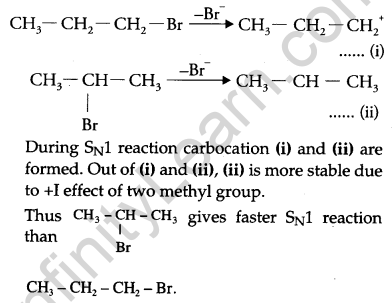
Question 5.
What is the formula of a compound in which the element Y forms ccp lattice and atoms of X occupy 273rd of tetrahedral voids? [1]
Question 6.
Write one similarity and one difference between the chemistry of lanthanides and that of actinides. [2]
Answer:
Similarity
- Both involve the filling of f-orbital (i.e. 4f and 5f)
- Both show contraction i.e. Lanthanide contraction and actinoid contraction.
Differences between lanthanoids and actinoids
| S.No. | Lanthanides | Actinoids |
| 1. | Except for Pm (promethium), all lanthanides are non-radioactive. | Actinides are radioactive. |
| 2. | Lathanoids do not show a wide range of oxidation state. | Actinides shows a wide range of oxidation state. |
| 3. | Lanthanoids ions are generally coloured. | Actinoid ions are colourless |
Question 7.
- Write down the IUPAC name of the following complex: [CO(NH3)5Cl]2+
- Write the formula for the following complex: Potassium tetrachloronickelate (II). [2]
Answer:
- [CO(NH3)5Cl]2: Pentaamminechlorocobalt (III) ion
- Potassium tetrachloronickelate(II): K2[NiCl4]
Question 8.
Write the reagents required in the following reactions:

OR
Arrange the following compounds in increasing order of their property as indicated:
(i) CH3COCH3, C6H5COCH3, CH3CHO (reactivity towards nucleophilic addition reaction)
(ii) Cl-CH2-COOH, F-CH2-COOH, CH3-COOH (acidic character).
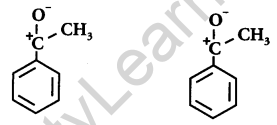
Answer:
(i) CH2=CH-CH2OH
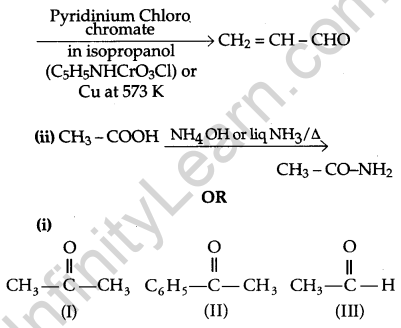
Nucleophiles are negatively charged entity, the positivity of carbon in the carbonyl group facilitates nucleophilic addition. Thus positivity of carbon in carbonyl group is in order HI > I > II. Due to +1 effect of -CH3 group and benzene ring π-cloud, the positivity of carbonyl carbon is decreased so much than (I) and (II). Thus nucleophilic addition order III > I > II.
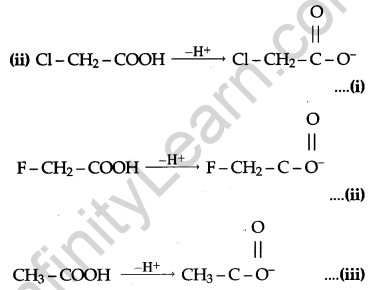
The stability order II > I > III. Due to +1 effect of -CH3 group electron density of oxygen is more. But in (I) and (II), -I effect of -F is more than -Cl. Thus II is more stabilized than I. Thus acidity order is II > I > III.
Question 9.
- On mixing liquid X and liquid Y, the volume of the resulting solution decreases. What type of deviation from Raoult’s law is shown by the resulting solution? What change in temperature would you observe after mixing liquids X and Y?
- What happens when we place the blood cell in water (hypotonic solution)? Give reason. [2]
Answer:
- Negative deviation of Raoult’s law occurred. There is an elevation of boiling point i.e., the temperature of the solution increases.
- When a blood cell is placed in water (hypotonic solution), water penetrate to blood cell and blood cell gets bulged and then disrupt.
Question 10.
Calculate the time to deposit 1.27 g of copper at cathode when a current of 2A was passed through the solution of CuSO4.
(Molar mass of Cu = 63.5 g mol-1, 1F = 96500 C mol-1). [2]
Answer:
Cu2+ + 2e– → Cu
63.5 g of copper deposited by 2 × 96500 C
1.27 g of copper will be deposited by

Question 11.
A solution is prepared by dissolving 10 g of non-volatile solute in 200 g of water. It has a vapour pressure of 31.84 mm Hg at 308 K. Calculate the molar mass of the solute. (Vapour pressure of pure water at 308 K = 32 mm Hg). [3]
Answer:
According to Raoult’s law,

Where
P0 → Vapour pressure of pure water
P → Vapour pressure of the solution
w → Weight of solute
m → Molecular weight of solute
W → Weight of solvent
M → Molecular weight of solvent

or, 0.005 m = 0.9 or, m = 180.
Thus the molar mass of the solute 180 gm./mol
Question 12.
(i) Name the method of refining to obtain silicon of high purity.
(ii) What is the role of SiO2 in the extraction of copper?
(iii) What is the role of depressants in froth floatation process? [3]
Answer:
(i) Zone refining is the method of refining to obtain silicon of high purity.
(ii) SiO2 combined with the iron in the copper ore to form iron(II) silicate slag which is easily removed. Thus it (SiO2) acts as a flux to remove the impurity of Iron oxide.
![]()
(iii) In the froth flotation process, depressant prevents the formation of froth. It is used to separate two sulphide ore by preventing the formation of froth of one sulphide ore and allowing the other to form the froth e.g., NaCN a depressant selectively prevents ZnS from coming in froth but allows PbS to come with the froth.
Question 13.
(i) Which one of the following is a polysaccharide:
Starch, maltose, fructose, glucose.
(ii) Write one difference between α-helix and β-pleated sheet structures of the protein.
(iii) Write the name of the disease caused by the deficiency of vitamin B12. [3]
Answer:
(i) Starch is a polysaccharide.
(ii)
| S.No. | α-helix | β-pleated |
| 1. | It is a rod-like structure. | It is a sheet-like structure. |
| 2. | It is stabilized by intramolecular hydrogen bonding. | It is stabilized by intermolecular hydrogen bonding. |
(iii) Pernicious Anaemia caused by the deficiency of Vitamin B12.
Question 14.
(i) What type of isomerism is shown by the complex [Cr(H2O)6] Cl3?
(ii) On the basis of crystal field theory, write the electronic configuration for d4 ion if Δ0 > P.
(iii) Write the hybridization and shape of [CoF6]3-.
(Atomic number of Co = 27). [3]
Answer:
(i) Hydration isomerism is shown by the complex [Cr(H2O)6] Cl3.
[Cr(H2O)5 Cl] Cl2 (H2O); [Cr(H2O)3 Cl3] 3(H2O).
(ii) Since Δ0 > P it is on splitting t42g eg0
(iii) [CoF6]3-: sp3d2 hybridisation and the shape is octahedral.

[CoF6]3- has four unpaired electrons. thus it is paramagnetic.
Question 15.
How can the following conversion be carried out:
(i) Aniline to bromobenzene
(ii) Chlorobenzene to 2-chloroacetophenone
(iii) Chloroethane to butane. [3]
OR
What happens when
(i) Chlorobenzene is treated with Cl2/FeCl3
(ii) Ethyl chloride is treated with AgNO2
(iii) 2-Bromopentane is treated with alcoholic KOH?
Write the chemical equations in support of your answer.
Answer:
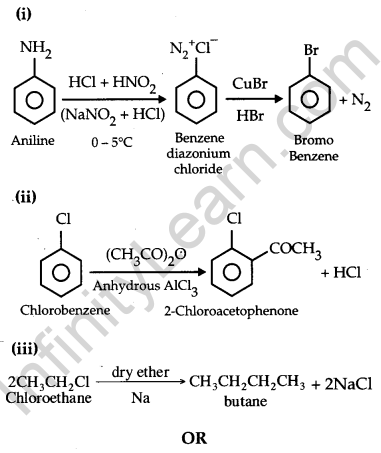
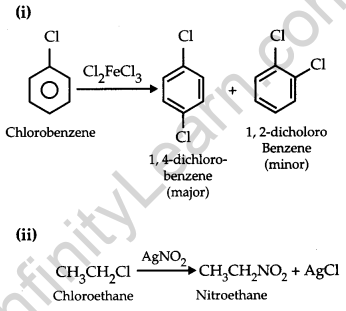
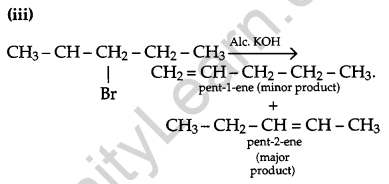
Question 16.
Examine the given defective crystal:

Answer the following questions:
(i) Is the above defect stoichiometric or non- stoichiometric?
(ii) Write the term used for this type of defect. Give an example of the compound which shows this type of defect.
(iii) How does this defect affect the density of the crystal? [3]
Question 17.
The conductivity of 2.5 × 10-4 M methanoic acid is 5.25 × 10-5 S cm-1. Calculate its molar conductivity and degree of dissociation.
Given: λ(H+) = 349.5 S cm2 mol-1 and λ0(HCOO–) = 50.5 S cm2 mol-1. [3]
Answer:
We know molar conductivity
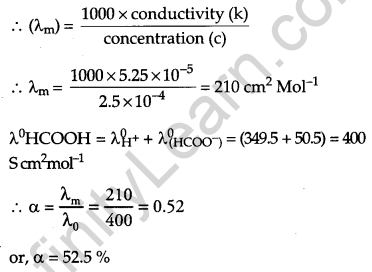
Question 18.
Write any three differences between Physisorption and Chemisorption. [3]
Answer:
| S.No. | Physisorption | Chemisorption |
| 1. | It forms multimolecular layers | It forms unimolecular layers |
| 2. | It is reversible | It is irreversible |
| 3. | Its does not require activation energy | It requires activation energy |
| 4. | It is not very specific | It is very specific |
| 5. | Force of attraction is Van Der Waals forces | Force of attraction is a chemical bond |
Question 19.
Give reasons for the following:
(i) Phenol is more acidic than methanol.
(ii) The C – O – H bond angle in alcohols is slightly less than the tetrahedral angle (109028′).
(iii) (CH3)3C – O – CH3 on reaction with HI gives (CH3)3C – I and CH3 – OH as the main products and not (CH3)3C – OH and CH3 – I. [3]
Answer:
(i) Phenoxide ion is more stabilized than CH3 – O- ion because of resonance:

Thus phenol is more acidic than CH3 – OH.
(ii) Due to the presence of lone pair on oxygen which causes repulsion, the bond angle in alcohol is slightly less than tetrahedral angle (109028′).
(iii) Since (CH3)3 C+ is more stabilized through +I effect of three methyl group thus (CH3)3 C – I and CH3 – OH formed on the treatment of HI with (CH3)3C-O-CH3.

Question 20.
Predict the products of the following reactions: [3]
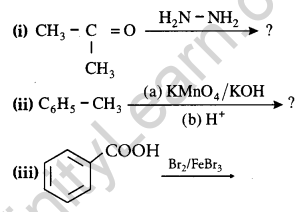
Answer:
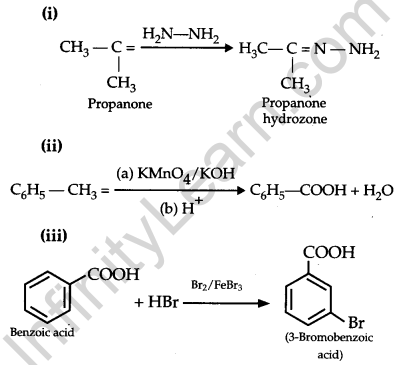
Question 21.
(a) Account for the following:
(i) Cu+ is unstable in an aqueous solution.
(ii) Transition metals form complex compounds.
(b) Complete the following equation:
Cr2Cr2O7– + 8H+ + 3NO–2 → [3]
Answer:
(a) (i) 2Cu+(aq) → Cu2+(aq) + Cu(s)
The higher stability of Cu2+ ion in aqueous solution is due to its greater negative charge than Cu. It compensates the second ionisation enthalpy of Cu involved in the formation of Cu2+ ions.
(ii) Since transition metals have unfilled or partially filled d-orbital thus to satisfy its octane forms complex compounds.

Question 22.
Write the names and structures of the monomers of the following polymers:
(i) Terylene
(ii) Buna-S
(iii) Neoprene [3]
Answer:
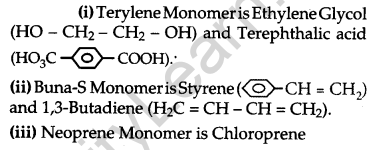
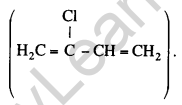
Question 23.
Seeing the growing cases of diabetes and depression among young children, Mr Chopra, the principal of one reputed school organized a seminar in which he invited parents and principals. They all resolved this issue by strictly banning junk food in schools and introducing healthy snacks and drinks like soup, lassi, milk, etc. in school canteens. They also decided to make compulsory half an hour of daily physical activities for the students in the morning assembly. After six months, Mr Chopra conducted the health survey in most of the schools and discovered a tremendous improvement in the health of the students.
After reading the above passage, answer the following questions:
(i) What are the values (at least two) displayed by Mr Chopra?
(ii) As a student, how can you spread awareness about this issue?
(iii) Why should antidepressant drugs not be taken without consulting a doctor?
(iv) Give two examples of artificial sweeteners. [4]
Answer:
(ii) Awareness can be spread by performing nukkad Natak in community, displaying posters, cartoons and slogans and by conducting seminars.
(iii) Antidepressant drugs have lots of side effects like indigestion, headache, stomach aches, drowsiness, weight gain. That is why it should not be taken without consulting with doctors.
(iv) Example of artificial sweeteners is Aspartame, Saccharin, Sucralose etc.
Question 24.
(a) Account for the following:
(i) Acidic character increases from HF to HI.
(ii) There is a large difference between the melting and boiling points of oxygen and sulphur.
(iii) Nitrogen does not form pentahalide.
(b) Draw the structures of the following:
(i) ClF3
(ii) XeF4 [5]
OR
(i) Which allotrope of phosphorus is reactive and why?
(ii) How are the supersonic jet aeroplanes responsible for the depletion of the ozone layer?
(iii) F2 has a lower bond dissociation enthalpy than Cl2. Why?
(iv) Which noble gas is used in filling balloons for meteorological observations?
(v) Complete the following equation:
XeF2 + PF5 → [5]
Answer:
(a) (i) Size of halide ions is of the order
F– < Cl– < Br– < I– with increase in size negative charge is dispersed throughout ions and ions gets stabilized. Thus acidity order
HF < HCl < HBr < HI.
(ii) Due to the presence of vacant d-orbital and combining forms of sulphur (S8) which is not present in oxygen, the cohesive energy of sulphur is more than oxygen leading to large melting point and boiling point.
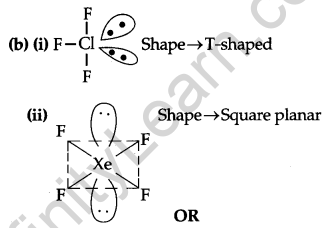
(ii) The exhaust emitted from supersonic jet aeroplane contains CO2, NO and other particles which are the killers of stratospheric ozone layer along with the supersonic sound produced by these aeroplanes are destroy the ozone layer.
(iii) Due to the smaller size and high electronegativity of fluorine, more energy is required to break the bond of F2 than Cl2. Thus F2 has lower bond dissociation energy than Cl2.
(iv) Helium (He) gas is used in filling balloons for meteorological observations because it is non-inflammable and light gas.
(v) XeF2 + PF5 → [XeF]+ [PF6 ]–.
Question 25.
An aromatic compound ‘A’ of molecular formula C7H6O2 undergoes a series of reactions as shown below. Write the structures of A, B, C, D and E in the following reactions: [5]

OR
(a) Write the structures of main products when benzene diazonium chloride reacts with the following reagents:
(i) H3PO2 + H2O
(ii) CuCN/KCN
(iii) H2O
(b) Arrange the following in the increasing order of their basic character in an aqueous solution:
C2H5NH2, (C2H5)2NH, (C2H5)3N
(c) Give a simple chemical test to distinguish between the following pair of compounds:
C6H5-NH2 and C6H5-NH-CH3 [5]
Answer:
A: C6H5COOH (Benzoic acid)
B: C6H5NH2 (Aniline)
C: C6H5NHCOCH3 (N-phenyl ethanamide)
D: C6H5CH2NH2 (Benzylamine)
E: C6H4(Br)3 (NH2) (2,4, 6-Tribromoaniline)
OR
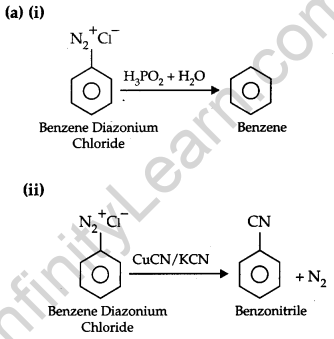
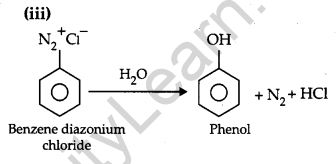
(b) C2H5NH2 < (C2H5)3N < (C2H5)2NH
+I effect of three C2Hs group increases the enormous availability of lone pair of nitrogen atom than +I effect of 2 ethyl group.
Thus the order of basicity is I < III < II.
(c) C6H5 – NH2 (Primary amine) and C6H5 – NH – CH3 (Secondary amine) can be distinguished by Hinsberg’s test. In this test, amines are allowed to react with Hinsberg’s reagent, benzene sulphonyl chloride (C6H5SO2Cl). Primary amines react with this reagent to form N-alkyl benzene sulfonyl amide which is soluble in alkali but secondary amines give sulphonamide which is insoluble in alkali.
Question 26.
For the hydrolysis of methyl acetate in aqueous solution, the following results were obtained:

(a) Show that it follows pseudo-first-order reaction, as the concentration of water remains constant.
(b) Calculate the average rate of reaction between the time interval 10 to 20 seconds.
(Given: log 2 = 0.3010, log 4 = 0.6021). [5]
OR
(a) For a reaction A + B → P, the rate is given by Rate = k[A][B]2
(i) How is the rate of reaction affected if the concentration of B is doubled?
(ii) What is the overall order of reaction if A is present in large excess?
(b) A first-order reaction takes 30 minutes for 50% completion. Calculate the time required for 90% completion of this reaction.
Answer:
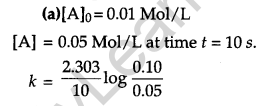
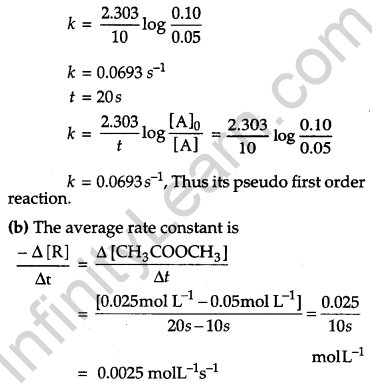
OR
(a) (i) Since the given reaction has order two with respect to reactant B, thus if the concentration of B is doubled in the given reaction, then the rate of reaction will become four times.
(ii) It the concentration of B is doubled i.e.; [B]2 the overall reaction will be two, because if A is present in large excess, then the reaction will be independent of the concentration of A and will be dependent only on the concentration of B.
Order of reaction = 2.
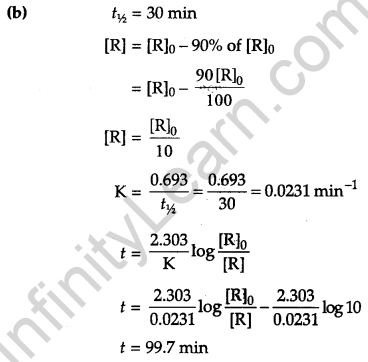
Note: All questions are same in Outside Delhi Set II and III.



